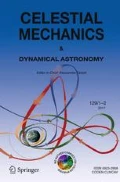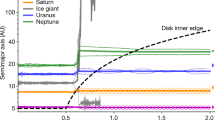Abstract
We examine the orbital evolution of planetesimals under the influence of Jupiter's perturbations and nebular gas drag, under the assumption that gas persisted in the asteroid region for some time after Jupiter attained its final mass. Two distinct mechanisms, associated with the 2 : 1 and 3 : 2 mean motion resonances, can excite eccentricities to high values, despite the damping effect of drag. If Jupiter's eccentricity was comparable to its present value, planetesimals can be temporarily trapped in the 2 : 1 resonance. Bodies crossing the 3 : 2 resonance can enter a region of phase space with overlapping high-order resonances. Both mechanisms can produce eccentricities greater than 0.5 for asteroid-sized planetesimals. The combination of resonant perturbations and drag causes secular decay of semimajor axes, resulting in migration of bodies from the outer to inner belt. Inclinations remain low, implying significant collisional evolution during this migration. Velocities of resonant bodies relative to the gas are highly supersonic; these would have been a source of shock waves in the solar nebula.
Similar content being viewed by others
References
Adachi, I., Hayashi, C. and Nakazawa, K.: 1976, 'The gas drag effect on the elliptic motion of a solid body in the primordial solar nebula', Prog. Theor. Phys. 55, 1756–1771.
Boss, A. P.: 1997, 'Giant planet formation by gravitational instability', Science 276, 1836–1839.
Dermott, S. F. and Murray, C. D.: 1983, 'Nature of the Kirkwood gaps in the asteroid belt', Nature 301, 201–205.
Franklin, F. and Lecar, M.: 2000, 'On the transport of bodies within and from the asteroid belt', Meteor. Plan. Sci. 35, 331–340.
Holman, M. J. and Murray, N. W.: 1996, 'Chaos in high-order mean motion resonances in the outer asteroid belt', Astron. J. 112, 1278–1293.
Hood, L. L.: 1998, 'Thermal processing of chondrule and CAI precursors in planetesimal bow shocks', Meteor. Plan. Sci. 33, 97–107.
Ida, S. and Lin, D. N. C.: 1996, 'Long term gas drag effect on the structure of the asteroid belt and its implications for the solar nebula', Astron. J. 112, 1239–1246.
Kary, D. M., Lissauer, J. J. and Greenzweig, Y.: 1993, 'Nebular gas drag and planetary accretion', Icarus 106, 288–307.
Kortenkamp, S. and Wetherill, G. W.: 2000, 'Terrestrial planet and asteroid formation in the presence of giant planets. I. Relative velocities of planetesimals subject to Jupiter and Saturn perturbations', Icarus 143, 60–73.
Lecar,M. and Franklin, F.: 1997, 'The solar nebula, secular resonances, and the asteroid belt', Icarus 129, 134–146.
Liou, J.-C. and Malhotra, R.: 1997, 'Depletion of the outer asteroid belt', Science 275, 375–377.
Marzari, F., Scholl, H., Tomasella, L. and Vanzani, V.: 1997, 'Gas drag effects on planetesimals in the 2:1 resonance with proto-Jupiter', Planet. Space Sci. 45, 337–344.
Miller, D. G. and Bailey, A. B.: 1979, 'Sphere drag at Mach numbers from 0.3 to 2.0 at Reynolds numbers approaching 104', J. Fluid Mech. 93, 449–464.
Nagasawa, M., Tanaka, H. and Ida, S.: 2000, 'Orbital evolution of asteroids during depletion of the solar nebula', Astron. J. 119, 1480–1497.
Peale, S.: 1986, 'Orbital resonances, unusual configurations, and exotic rotation states among the planetary satellites', In: J. A. Burns and M. S. Matthews (eds), Satellites, Univ. Arizona Press, Tucson, pp. 159–223.
Podosek, F. and Cassen, P.: 1994, 'Theoretical, observational, and isotopic estimates of the lifetime of the solar nebula', Meteoritics 29, 6–25.
Pollack, J., Hubickyj, O., Bodenheimer, P., Lissauer, J., Podolak, M. and Greenzweig, Y.: 1996, 'Formation of the giant planets by concurrent accretion of solids and gas', Icarus 124, 62–85.
Shu, F., Johnstone, D. and Hollenbach, D.: 1983, 'Photoevaporation of the solar nebula and the formation of the giant planets', Icarus 106, 92–101.
Ward, W. R.: 1981, 'Solar nebula dispersal and the stability of the planetary system I. Scanning secular resoance theory', Icarus, 47, 234–264.
Weidenschilling, S. J. and Davis, D. R.: 1985, 'Orbital resonances in the solar nebula: implications for planetary accretion', Icarus 62, 16–29.
Weidenschilling, S. J.: 1977, 'Aerodynamics of solid bodies in the solar nebula', Mon. Not. R. Astr. Soc. 180, 57–70.
Weidenschilling, S. J., Marzari, F. and Hood, L. L.: 1998, 'The origin of chondrules at Jovian resonances', Science 279, 681–683.
Whipple, F. L.: 1972, 'On certain aerodynamic processes for asteroids and comets', In: A. Elvius (ed), From Plasma to Planet, Wiley, New York, pp. 211–232.
Author information
Authors and Affiliations
Rights and permissions
About this article
Cite this article
Marzari, F., Weidenschilling, S. Mean Motion Resonances, Gas Drag, and Supersonic Planetesimals in the Solar Nebula. Celestial Mechanics and Dynamical Astronomy 82, 225–242 (2002). https://doi.org/10.1023/A:1015067000812
Issue Date:
DOI: https://doi.org/10.1023/A:1015067000812




